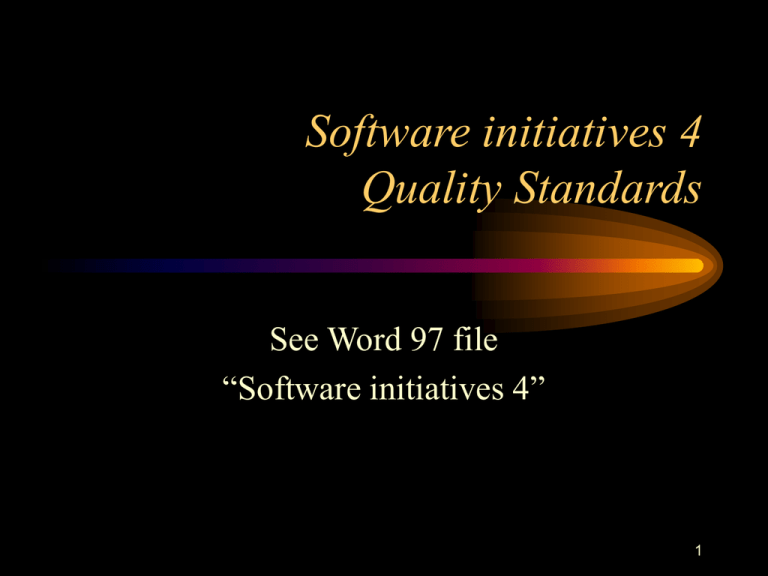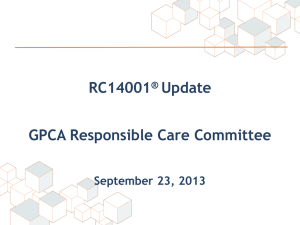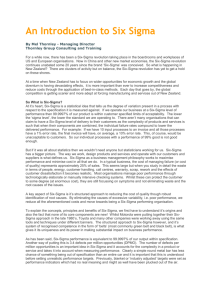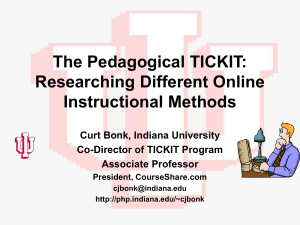Software initiatives 4
advertisement

Software initiatives 4 Quality Standards See Word 97 file “Software initiatives 4” 1 Quality (BURKS) • The totality of features and characteristics of a product or service that bear on its ability to satisfy stated or implied needs. Not to be mistaken for "degree of excellence" or "fitness for use" which meet only part of the definition. • There is no single, unambiguous definition. 2 Quality Assurance (BURKS) • A planned and systematic pattern of all actions necessary to provide adequate confidence that the product optimally fulfils customer's expectations. • This term can be used generically to refer to all activities that affect quality in any way. • It also has a number of more specific definitions, such as the label assigned to quality assurance departments and to quality assurance personnel. 3 Quality Control (BURKS) • The assessment of product compliance. Independently finding deficiencies assures compliance of the product with stated requirements. • This term can be used generically for the same concepts as "quality assurance" or more specifically to specific combinations of inspections and test steps applied to software projects. 4 Quality Standards (BURKS) • "The nice thing about standards is that there are so many of them to choose from", – Standards are necessary for interworking, portability, and reusability. – They may be de facto standards for various communities, or officially recognised national or international standards. 5 Standards? – Every country has a standards organisation. – In addition, many industries and technologies also have standards bodies, such as the well known standards published by the IEEE (Institute of Electrical and Electronic Engineers) and the European Computer Manufacturers Association (ECMA). – Many large corporations have in-house standards. Indeed, for software quality the internal standards used at companies such as AT&T, IBM, Hewlett Packard, Motorola, and many others are among the most effective in the world. – In some cases, the in-house standards pioneered entirely new concepts such as Motorola's well known Six-Sigma quality standard. 6 Some standards-issuing organisations • Allied Quality Assurance Publications (AQAP) produced by NATO • American National Standards Institute (ANSI) • British Standards Institute (BSI) • Department of Defence (DoD) in the United States • Department of Defence (Def) in the United Kingdom • Deutsches Institut fur Normung (DIN) • European Computer Manufacturing (ECMA) • European Space Agency (ESA) 7 Some more standards-issuing organisations • • • • • • • • Federal Information Process Standards (FIPS) International Organisation for Standards (ISO) Institution of Electrical Engineers (IEE) Institute of Electrical and Electronic Engineering (IEEE) Japanese Industrial Standards Committee (JISC) Japanese Union of Scientists and Engineers (JUSA) Software Publishers Association (SPA) Various in-house standards and guidelines by specific companies 8 Oh Dear! • “On the whole, the software standards associated with quality have had only a marginal effect on quality.” • “Generally speaking, software standards are based on the subjective views of the standards committee, and seldom have even much solid empirical data behind them.” 9 European Software Initiatives • The combined software population of Western Europe and the U.K. is somewhat larger than the software population of the United States and very energetic in terms of quality initiatives, standards, conferences, and Internet communication channels. • Quality initiatives such as the ISO 90009004 standards, now have global impact. 10 The Good • The same industries tend to achieve the best quality results in every industrialised country in Europe, North America, South America, the Middle East, and the Pacific Rim. • These industries share a common characteristic that their software supports large and complex physical devices which need close to zero-defect software in order to operate successfully. 11 The Good Aerospace manufacturers Commercial systems software manufacturers Computer manufacturers Defence system manufacturers Medical instrument manufacturers Telecommunication manufacturers 12 The Bad • Several industries where software quality lags in the United States appear to be rather good in much of Europe: insurance and banking software, for example. • In the USA the insurance and banking software development practices tend to be somewhat less formal and more casual than the six industries with the best quality results. 13 The Bad • The financial and insurance industries have also been rushing to get into the • client/server world, – where quality is often marginal and even worse than equivalent mainframe applications. – By contrast, financial and insurance software in Europe has a higher probability of rigor during development, more care in quality control, and a greater use of non-test defect removal methods such as inspections. 14 The Ugly • The quality of government software seems somewhat better in several European countries than here in the United States. • Software produced by some of the civilian agencies of the Federal Government in the United States tends to lag the private sector in terms of defect prevention and defect removal operations, and hence gets deployed with substantially more errors than commercial norms. 15 The Ugly • By contrast, government-produced software in Belgium, Italy, France, Sweden, and the U.K. is sometimes equivalent to information systems software produced by public company or their outsourcing partners. 16 Differences Requirements and design approaches are often more formal in Europe, and some of the European front-end approaches are technically very sophisticated On the whole, formal methodologies are used more often than in the United States, and much more often in the information systems and client/server domains where U.S. practices tend to be rather careless. The overall result is that European MIS software projects often run about 10% to 20% below equivalent U.S. projects in requirements and design errors. 17 Differences The patterns of programming language usage tend to differ between the U.S. and Europe. Logic-based languages such as ALGOL, Prolog, and Miranda have a higher frequency of use as do strongly-typed languages such as PASCAL and Modula-2. The usage of Ada83 for civilian projects is far more common in Europe than in the United States. Programming language research is very strong in much of Europe. 18 Differences Usage of commercial software cost estimating tools and other software project management aids are less common in Europe than in the United States, although both sides of the Atlantic are now experiencing rapid growth in project management technologies. Usage of function point metrics for data normalisation is roughly equal between the United States and Europe in terms of frequency of use. 19 Differences Membership in various function point users' groups is growing at about 50% per year in every industrialised country, while usage of "1ines of code" is declining by about 10% per year. In Europe, large function point associations have been formed in France, Italy, the Netherlands, the United Kingdom, and also a multi-country Scandinavian function point group. Function point usage is growing but not yet formally organised in Austria, Belgium, Germany, Greece, Portugal, or Spain. 20 Differences Although the factor is more important for productivity studies than for quality studies, the rather lengthy European vacation periods (running to more than 30 days per year in some cases) tend to favour countries with more working days per year, such as the United States, Japan, and India. 21 Differences Although a difficult topic to explore since many tracking systems don't record it, the amount of unpaid overtime applied to software projects (i.e., unpaid work in the evenings, on weekends, and on public holidays) appears low in Europe and the United Kingdom compared to the United States and Japan. Unpaid overtime is so often part of software projects that it can exert an overall productivity influence that approaches 20%. 22 Differences • One of the problems of doing direct international comparisons between the United States and Europe is that the metrics are sometimes different. • A survey of refereed software engineering journals carried out a few years ago noted that: one-third of the articles using "lines of code" were based on physical lines; one-third were based on logical statements; the remaining third did not even state the basis of the lines of code count. almost 20% of the articles did not even identify the languages from which the study was based. 23 Differences • Of course, there are function point variants too. • Between the United States and Europe, at least a dozen function point variations can now be enumerated. • On a global basis, however, standard IFPUG function points have about 90% penetration in terms of published books, articles, and data. 24 ISO 9000 (BURKS) • A set of international standards for both quality management and quality assurance that has been adopted by over 90 countries world-wide. • The ISO 9000 standards apply to all types and sizes of organisations. • Documentation is at the core of ISO 9000 – Say what you do. – Do what you say. – Write it down. 25 ISO 9000 The standards require: a standard language for documenting quality processes; a system to manage evidence that these practices are instituted throughout an organisation; and third-party auditing to review, certify, and maintain certification of organisations. 26 ISO 9000 • Say what you do. • Do what you say. • Write it down. 27 Used where? • The ISO standards are used intermittently in the United States, Japan and the Pacific Rim, South America, the Middle East, and Eastern Europe. • The ISO standards have had far and away their greatest deployment in Europe and the United Kingdom. • Indeed, they are now often required for marketing products within the European Community (EC). 28 Used where? • Not every company utilises the ISO standards in Europe, but the penetration is probably now in excess of 20% in Western Europe and the U.K. as opposed to perhaps 3% elsewhere based on interviews with software managers and QA personnel. • A few U.S. companies that produce only domestic software respond to questions about ISO standards with a question of their own: "What are they?" 29 ISO 9001 and ISO 9000.3 • ISO 9001 is the primary standard on how products are built, and a guideline • ISO 9000.3 explains the ISO approach in a software context. 30 But ... • “So far as can be determined, there is not yet any tangible or perceptible difference in the software quality levels of companies which have been certified when compared to similar companies in the same industries which have not been certified.” 31 More But ... • Currently the most tangible aspects remain – the high costs of the ISO certification process, – the large volumes of planning and control documents, and – the time required to achieve certification. 32 Motorola’s 2 Objections • ISO certification was used for marketing purposes with an implied assertion that achieving ISO certification meant high quality levels regardless of the lack of empirical data demonstrating that point. Motorola's Vice President of Quality, bluntly stated that was false advertising. • The ISO standards themselves lacked some of the key quality elements found in Motorola's own quality standards and could be viewed as a step back rather than a step forward in terms of quality methodology. 33 What? • Some ISO users have observed that it is not the place of the ISO 9000-9004 standards to actually improve quality. • Their purpose is simply to ensure that effective practices are followed, and are not in and of themselves a compilation of best current practices. 34 Does ISO 9001 ... reduce software defect potentials below 5 per function point? raise defect removal efficiency levels above 95% ? reduce the number of had test cases below 15% ? reduce the rate of "bad fix" injections below 7% ? increase reliability under field conditions? increase customer satisfaction levels? have any affect on data quality? reduce the number of cancelled or delayed projects? reduce the incidence of litigation for breach of contract? reduce the incidence of litigation for poor quality control? 35 Data? • Software standards groups should consider the methods through which medical and pharmaceutical standards are set. • Although medical standards are not perfect, their concept is that a therapy should be proven to be effective and its side effects understood before it becomes a standard. • It would be a strong statement that software is approaching the status of a real profession if software standards included information similar to medical and pharmaceutical standards on efficacy, counter-indications, known hazards, and potential side effects. 36 Data? • Software standards are normally totally published in a way that is totally devoid of empirical data regarding their effectiveness when the standards are first promulgated. • The fact that there may possibly be negative or harmful side effects from following the standards is usually not even discussed, although negative side effects are a major section of medical and pharmaceutical standards. • Standards organisations should collect data, and should encourage auditors and assessors to move toward quantification and empirical results rather than subjective opinions. 37 TickIT • TickIT is a method of evaluating software quality that originated in the late 1980s by the BCS. • The TickIT approach is based on ISO 9000.3 and is intended to serve as a consistency check on auditing ISO standards as applied to software. • The TickIT concept includes both training and certification of auditors, who are then qualified to perform ISO audits. • The TickIT approach includes on-site interviews and assessments and envisions the production of a number of quality-related plans and reports. 38 TickIT • TickIT is widely used throughout the United Kingdom, and especially so for projects involving the government. • Since the ISO standards did not originate for software, there is a strong need to customise or tailor the ISO standards and audits to the software world. The TickIT concept is to serve as a translator of ISO philosophy into the software domain. • Empirical data on the effectiveness of the TickIT approach is sparse. – The TickIT concept and the ISO standards ignore both functional metrics and defect removal efficiency measurement. 39 SPICE • "Software Process Improvement and Capability Evaluation." • The SPICE approach is a composite software assessment method based in part on – the Software Engineering Institute (SEI) capability maturity model (CMM); – the Bell Northern Research TRILLIUM assessment approach; and – the International Standards Organisation (ISO) 9000-9004 standard series. 40 SPICE • The SPICE approach is moving toward an international standard for software process assessments that is intended to improve the relationship between software contractors and clients. • Many of the SPICE concepts are derived from the needs of large corporations and large government agencies whose software contracts might run to many millions of dollars for key contracts, and billions of dollars in aggregate. 41 SPICE • SPICE is a bold and ambitious program, and like many bold programs, also has some risks associated with it. • It is premature to judge the overall impact of SPICE since it is still evolving. • The direction is promising, but when so many organisations are involved in standards the results are often cumbersome and unsuitable for small projects and small companies. 42 Software development in 1984 • More than half of large software systems were over 12 months late. • The average costs of large software systems was more than twice the initial budget. • The cancellation rate of large software systems exceeded 35%. • The quality and reliability levels of delivered software of all sizes were poor. • Software personnel were increasing by more than 10% per year. • Software was the largest known business expense that could not be managed. 43 Software Engineering Institute • In order to explore software issues, and especially those topics associated with defence contracts, the Department of Defence in 1984 funded a new software research facility. • This was the essential origin of the Software Engineering Institute. • The SEI is located on the campus of Carnegie Mellon University in Pittsburgh. • It is a non-profit software research organisation funded primarily by the US government through the Defence Advanced Research Project agency (DARPA). 44 SEI Assessment Approach • The SEI assessment data is collected by means of on-site interviews using both a standard questionnaire and also observations and informal data. • Once collected, the assessment data is analysed, and used to place a software organisation on one of the five plateau of the now well-known SEI “Capability Maturity Model” • CMM 45 System Size? • The SEI assessment approach originally dealt primarily with the software processes and methodologies used by very large companies that produced very large systems. • It was derived from the best practices used by leading corporations such as IBM and ITT which employ from 5,000 to more than 25,000 software professionals, and which could safely build systems in excess of 1,000,000 lines of code or 10,000 function points. 46 SEI CMM Approximate Distribution of U.S. Software Enterprises Based on the SEI Capability Maturity Model (CMM) Results SE1 Maturity Level 1 = Initial 2 = Repeatable 3 = Defined 4 = Managed 5 = Optimising Meaning Chaotic Marginal Adequate Good to excellent State-of-the-art Frequency of Occurrence 75.0% 15.0% 8.0% 1.5% 0.5% CMM • The Software Engineering Institute's model of software engineering that specifies five levels of maturity of the processes of a software organisation. • CMM offers a framework for evolutionary process improvement. • Originally applied to software development (SECMM), it has been expanded to cover other areas including Human Resources and Software Acquitition. 48 Focii - key process areas: Level - 1 Initial • Heroes • None. 49 Level 2 - Repeatable • Project Management – • Software Project Planning, Software Project Tracking and Oversight, Software Subcontract Management, Software Quality Assurance, Software Configuration Management, Requirements Management. 50 Level 3 - Defined • Engineering Process • Organisation Process Focus, Organisation Process Definition, Peer Reviews, Training Program, Inter-group Coordination, Software Product Engineering, Integrated Software Management. 51 Level 4 - Managed • Product and Process Quality • Software Quality Management, Quantitative Process Management. 52 Level 5 - Optimising • Continuous Improvement • Process Change Management, Technology Change Management, Defect Prevention. 53 P-CMM • The SEI assessment program was criticised for concentrating on too narrow a set of topics, and ignoring other topics such as personnel, compensation, hiring practices, and the like. • In 1995 the SEI filled a notable gap by publishing a People Capability Maturity Model or P-CMM. • The lead researcher on the P-CMM was a cognitive psychologist, Dr. Bill Curtis. • He had formerly headed the SEI assessment practice 54 Level 1: initial • Characterised by random or chaotic development methods with little formality and uninformed project management. • Some smaller projects may be successful due to the capabilities of individual staff members, large systems are often failures and the overall results are marginal to poor. • In terms P-CMM, such organisations are asserted to be deficient in training at both the technical staff and managerial levels. 55 Level 1: initial • SEI does not recommend any key process areas for Level 1 organisations on the grounds that they are not sophisticated enough to deploy methods consistently and will probably botch things up if they try. • Moving from Level 1 to Level 2 is the most difficult transition point. • For a large company with perhaps 1,000 software personnel, the move from Level 1 to Level 2 can take from 18 to more than 36 months. 56 Level 2: repeatable • Level 2 or Repeatable organisations have introduced at least some rigor into project management and technical development tasks. • Approaches such as formal cost estimating are noted for project management, and formal requirements gathering are often noted during development. • Compared to the initial level, a higher frequency of success and a lower incidence of overruns and cancelled projects can be observed. 57 Level 2: repeatable • In terms P-CMM, the Level 2 organisations have begun to provide adequate training for managers and technical staff. • Further, they have become aware of the importance of professional growth and the need for selecting and keeping capable personnel. 58 Level 2: repeatable • The key process areas which SEI recommends for Level 2 organisations include requirements management, project planning, resource tracking, quality assurance, and configuration management plus subcontract management for projects that utilise multiple contractors. • The key process areas for Level 2 of the People CMM include compensation, training, staffing, communication, and work environment. 59 Level 2 to 3? • Moving from Level 2 to Level 3 is not as difficult as the first move, since organisations have usually become used to the idea that change will be necessary. • However, the same size organisation illustrated previously with 1000 software personnel, should not expect to go from Level 2 to Level 3 in less than a year, and it may take more than 18 months. 60 Level 3: defined • Level 3 or Defined organisations have mastered a development process that can often lead to successful large systems. • Over and above the project management and technical approaches found in Level 2 organisations, the Level 3 groups have a welldefined development process that can handle all sizes and kinds of projects. 61 Level 3: defined • In terms of the P-CMM, the Level 3 organisations have developed skills inventories and are now capable of selecting appropriate specialists who may be needed for critical topics such as testing, quality assurance, web mastery, and the like. • Level 3 organisations should be capable of effective software reusability programs. 62 Level 3: defined • The key process areas which SEI recommends for Level 3 organisations include establishing an effective organisational infrastructure, training of both managers and technical staff, inter-group co-ordination, and the utilisation of formal design and code inspections. • The key process areas for Level 3 of the P-CMM include career development, competency-based practices, work force planning, and analysis of the knowledge and skills that are needed by the organisation. 63 Level 3 to 4? • Organisations that achieve Level 3 sometimes rest on their laurels, since Level 3 is the minimum level needed to bid on some U.S. defence projects. • Organisations that are pursing "best in class" goals will find Level 3 to be only a way station. • For these energetic groups, moving from Level 3 to Level 4 can sometimes be accomplished in less than 12 months. 64 Level 4: managed • Level 4 or Managed organisations have established a firm quantitative basis for project management and utilise both effective measurements and also effective cost and quality estimation. • In terms of the People CMM, the Level 4 organisations are able to not only monitor their need for specialised personnel, but are actually able to explore the productivity and quality results associated from the presence of specialists in a quantitative way. 65 Level 4: managed • Long-range predictions of future needs are also part of the Level 4 P-CMM assertions. In addition, Level 4 organisations would make extensive use of mentoring. • The key process areas which SEI recommends for Level 4 organisations include quantification of defect levels, productivity levels, and activity-based costing. • Level 4 organisations should be approaching 50% levels of software reuse for both design, code, and testing materials. • The key process areas for Level 4 of the P-CMM include mentoring, team building, organisational competency, and the ability to predict and measure the effect of specialists 66 and teams in a quantitative manner. Level 4 to 5? • Moving from Level 4 all the way to Level 5 is not easy to quantify because the actual criteria for Level 5 are somewhat abstract. • There is no reason to assume that a transition from Level 4 to Level 5 should take more than 12 months. 67 Level 5: optimising • Level 5 or Optimising organisations are assumed to have mastered the current state-of-the-art of software project management and development. • Such groups are expected to be the pioneers who are capable of building entirely new methods that advance the state of the art beyond current levels. • Although not explicitly stated, Level 5 organisations should be approaching or exceeding a volume of about 75% of reusable design, code, and test materials. 68 Level 5: optimising • In terms of the P-CMM, the requirements are an extension of Level 4 and hence different more in degree than in kind. • The P-CMM stresses both coaching and rewards for innovation at Level 5. • The key process areas recommended for Level 5 include defect prevention and advancing the fundamental software engineering and management technologies, plus rapid and effective technology transfer and deployment of improvement approaches. • The key process areas for the P-CMM include encouragement of innovation, coaching, and personal 69 competency development. Same again? • When the SEI capability maturity model was first published it was asserted that both quality and productivity levels would improve at the higher levels. • This is an area where SEI shares the bad habits of the rest of the software industry. The SEI assertions about quality and productivity were initially made without any kind of study or empirical evidence being collected. • In fact, even in 1997 the SEI assessment approach itself still does not include the collection of quantitative information on either productivity rates or quality levels. • This is a serious flaw in the SEI assessment procedure. 70 Level overlaps Software delivered (to customer) defects (per function point) at each level of the CMM Level 1 2 3 4 5 Minimum Average 0.150 0.750 0.120 0.624 0.075 0.473 0.023 0.228 0.002 0.105 Maximum 4.500 3.600 2.250 1.200 0.500 “Six-Sigma” Quality Levels • The Motorola Corporation has received substantial interest in its famous “six-sigma” quality program for hardware and manufactured components. • The phrase refers to defect densities of 3.4 in a million. • Since the six-sigma definition is hard to visualise for software, an alternative approach would be to achieve a cumulative defect removal efficiency rate of 99.999999% prior to delivery of a product. • This method is not what Motorola uses but it helps to clarify what would have to be done to achieve six-sigma results for software projects. 72 “Six-Sigma” Quality Levels • Since the current U.S. average for software defect removal efficiency is only about 85%, and quite a few software products are even below 70%, it may be seen that software producers have some serious catching up to do. • As it happens, there are a few software products which appear to have achieved six-sigma quality levels. • In 30 years Capers Jones has observed four projects that achieved six-sigma results in their first year of deployment out of a total of almost 10,000 projects. 73 “Six-Sigma” Quality Levels • Surprisingly, the prognosis for achieving six-sigma quality levels for software is fairly good. • The best of the available technologies today can approach this level if – a full suite of defect prevention and – defect removal operations are carried out synergistically. • Indeed, for software projects where reuse of certified materials top 75% by volume, and where formal inspections are used to augment testing, six-sigma quality levels should be achieved routinely. 74 “Six-Sigma” Quality Levels • That does not mean that the software industry is ready to try. • There are both sociological and technical reasons that quality is held back, such as – the widespread lack of appreciation of the correlation between high quality and short schedules and – the lack of commercial reusable materials certified to zero-defect levels. 75








